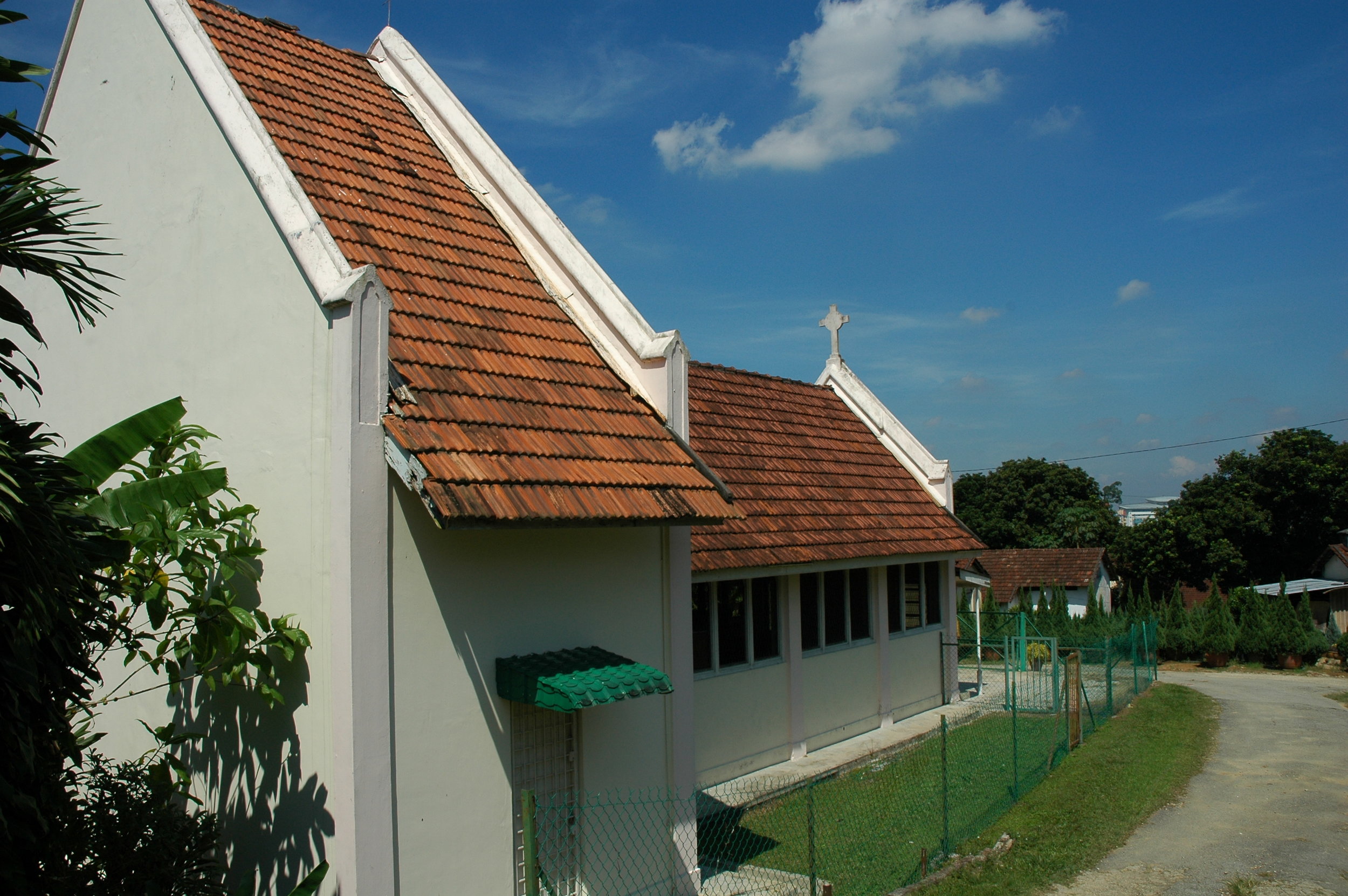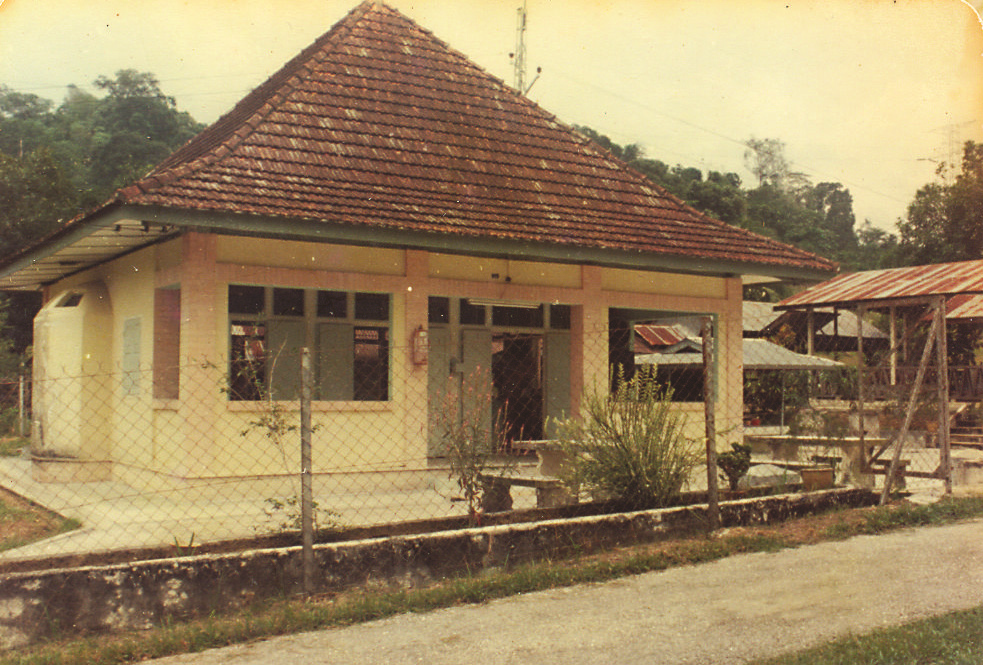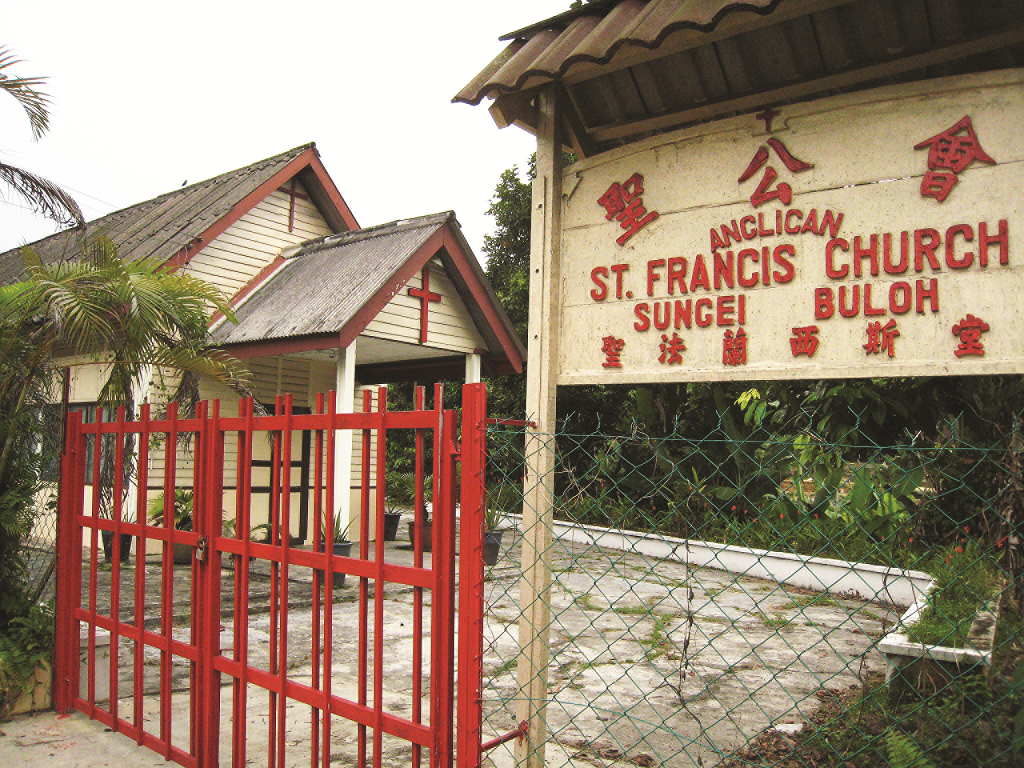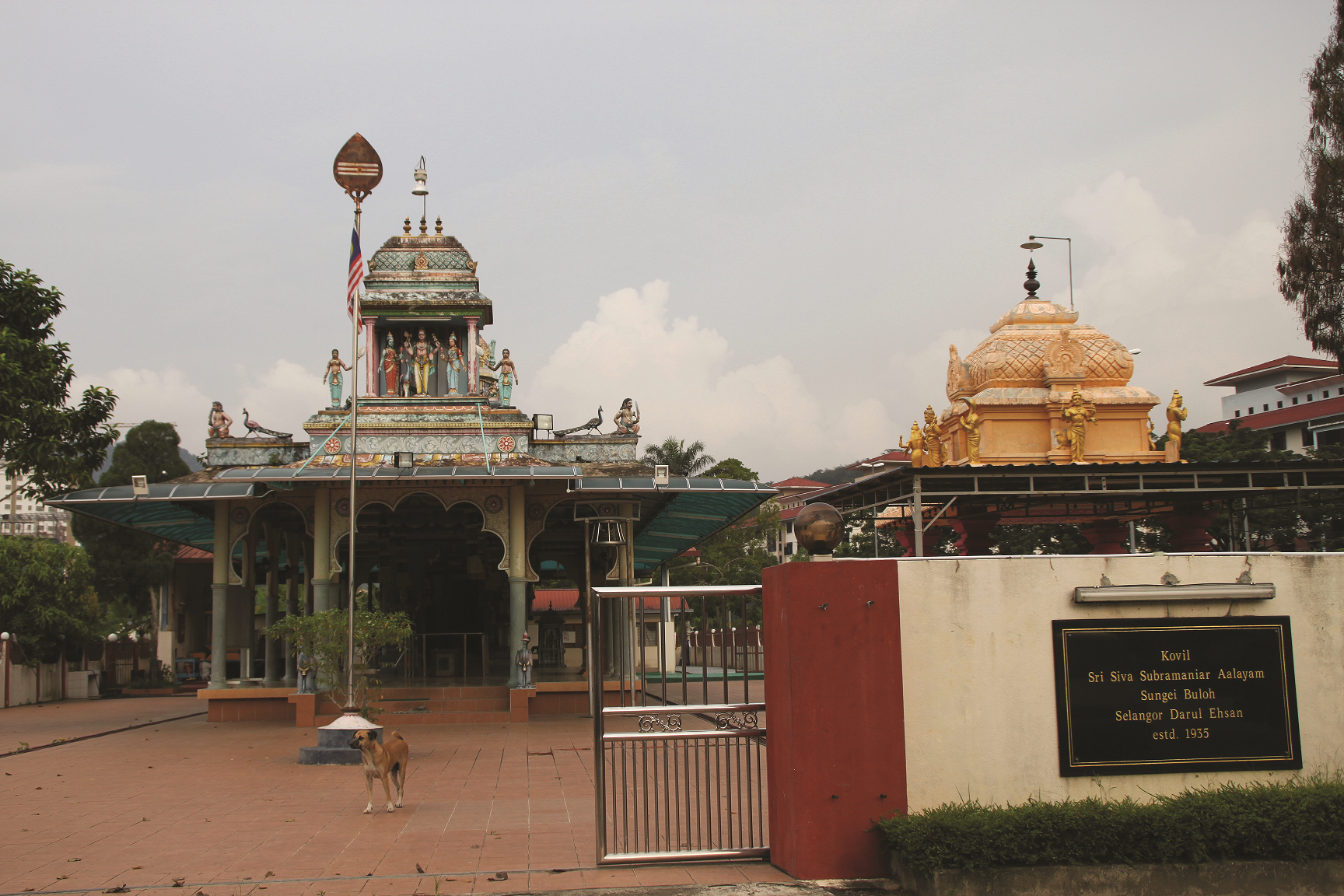Clubs and Associations
In the past, contracting leprosy was like getting a death sentence – those diagnosed with it could do nothing but hide from the world in fear while the bacteria eat away at their flesh and bone. The Valley of Hope, founded by the British colonial government in 1930, pulled leprosy patients out of the horrible concentration camps and offered them a hygienic and healthy environment, so that they might live a dignified life and regain some form of normalcy in their life.
Members of the Teochew Association getting ready for the Wesak procession at the association’s premises. (photo courtesy of Lee Sow Cheng)
At the Sungai Buloh Settlement the residents enjoy great freedom in setting up clubs and associations. They have been encouraged to form various organisations and activities as to jump-start their new life here at the Valley of Hope. At its peak the colony was home to 2,440 residents and they had more than a dozen clubs and associations to choose from.
The Valley of Hope is a community made up of people from different ethnic groups, clanship and religious beliefs, thus naturally it led to clubs and associations to be formed along these lines. There are also non-ethnic-based organisations open to all races, such as the Ng Fook Tong, Rehabilitation Club, Green Club, Tong On Association and so on.
Lee Chor Seng (photo by Lian Ling Siong)
The Club of the Club
Ng Fook Tong, the first association founded in the Valley of Hope, has a long history. According to the Sungai Buloh Settlement Council Member, Tan Ean Nee, when the patients in Kuala Lumpur’s Setapak Camp moved to the Valley of Hope in 1930, they brought with them the existing Ng Fook Tong to Sungai Buloh and resumed their activities in the same year. She said: “Ng Fook Tong” means “the hall of the five signs of prosperity and smooth-sailing”. This association is technically a “federation” of all the clubs and associations in the settlement and all inmates are naturally a part of it. Its council is made up of presidents and treasurers of more than ten organisations in the settlement and hence it is known as, “the club of the club.”
Ng Fook Thong held a monopoly over the fruits that grew within the settlement. (photo by Tan Ean Nee)
Lee Chor Seng, the incumbent Vice-President of the Sungai Buloh Settlement Council, and Ng Fook Tong’s President, has been active in Ng Fook Tong since the 1980s. He said that all rambutan trees growing on no man’s land in the settlement, are managed by Ng Fook Tong and profit from the sale of its fruit is the organisation’s main source of revenue. With the money, Ng Fook Tong would give a RM200 angpow to every inmate in the settlement during Chinese New Year, annually.
As the majority of the patients are Chinese, there are quite a number of clan-based associations and clubs for the Chinese inmates, such as the Chinese Mutual Aid Association, Hokkien Association, Teochew Association, Kheng Chew Association, Kwong Sai Association, Charity Mutual Aid Association, and so on. Meanwhile, the Malay inmates founded the Malay Club, and the Indian inmates; the Indian Mutual Aid Association, Indian Club, and the Indian Muslim Club.
Krishnan Murugan (photo by Lian Ling Siong)
A club for everyone
Krishnan Murugan, an Indian teacher who was admitted in 1948, said that the settlement had about 400 Indians at the time and every day after meal, all of them would gather and play cards at the Indian Mutual Aid Association and the Indian Club.
Unfortunately, the Malay Club, Indian Club and the Indian Muslim Club in the East Section were demolished in October 2007 to make way for the medical faculty of Universiti Teknologi MARA.
A member of the Settlement Council, Haji Rauf, recalls that Chalet No. 202 in the East Section was used as the base for the Indian Muslim Club but it has since been demolished in 2007. He remembers that the membership fee was 50 cents and the monthly subscription fee was 20 cents. Members living in the hospital wards were entitled to the club’s support fund and aid, while children of its members were also entitled to a monthly allowance.
Indian Mutual Aid Association at the Central Section. (photo courtesy of Krishnan)
Haji Rauf (photo by Mango Loke)
Rauf said that the Malay Club was also located in the East Section and was also demolished in 2007. The club used to have over 30 members. It was founded to promote sports and social activities, as well as ensuring the welfare of its members; including making funeral arrangements for deceased members.
Rauf says: “I was a member of the club too in the 1960s. The membership fee for inmates who had a job was 30 cents while the fee for the jobless was 10 cents, and the monthly subscription fee was 20 cents. PERMATA and UMNO would also donate cakes and gifts during Hari Raya Haji and Hari Raya Aidilfitri.”





There are also places for religious worship in the Valley of Hope, such as a mosque, a Hindu temple, Buddhist Temple, Fuh Huey Kong, the Gospel Hall, the Anglican St Francis Church, and the Roman Catholic Church. Each of these religious organisations had their own committees and would hold various religious events and celebrations.
Chinese Mutual Aid Association at Central Section. (photo by Tan Ean Nee)
A friend in need, in life and death
Apart from the religious organisations, most of the clubs and associations were founded with a common objective in mind: to connect one another and to undertake funeral arrangements for their members. The objectives of the Chinese Mutual Aid Association, as stated in its constitution, are: “to connect the fellow members, improve public welfare, mediate disputes between members, and to help in arranging funerals for members who have passed on. In the event of a member’s passing, all members (except for the inpatients) had to contribute 10 cents to a mutual aid fund as a form of condolence and would go towards the funeral expenses of the deceased member. The fund was collected by the person in charge, who would then assign the right person to handle the funeral arrangements.”
Many inmates are from poor backgrounds. When they first arrived at the settlement, it was common for them to have feelings of loneliness and a sense of helplessness that comes from being in a new environment so far away from home. Some have even lost touch with their families. By joining the various associations here, they are able to connect with other like-minded patients. In the case of the Chinese inmates, they are able to meet those who share their ancestral hometown and who speak the same Chinese dialect when they join the clan-based associations. Support from clan members help patients adapt to their new lives sooner by providing them with a sense of belonging. Furthermore, being a member assures them that in the event of their death, they need not worry about funeral rites as the association will help arrange for a coffin and a simple funeral.
Green Club, some inmates referred to it as the “Ang Mor Club”or Westerners Club.
(photo by Dr Lim Yong Long)
The Green Club, or better known as, The Ang Moh Club
Another notable club was the Green Club, a unique organisation in the settlement, established to provide a recreational and networking platform for the English-educated patients and the resident doctors and nurses during the British rule, who were often of foreign origin. It was commonly known as the “ang moh club” (westerners’ club) amongst the patients. Founded in 1928, the club was named after Dr Richard Green, a bacteriologist who was in charge of the Setapak Leprosy Camp between 1925 and 1928. Located in the East Section, the club had recreational facilities such as a pool table, chessboards, a reading room and so on. According to the accounts of a Green Club Member in The Valley of Hope Pictorial History Book, (the late) Lee Sow Cheng said that the club would hold grand parties, funfairs, stage performances, film festivals, as well as anniversary and festive celebrations every year.
Lee Sow Cheng (photo by Tan Ean Nee)
“I was very active in the club. I participated in the fancy dress contest during the anniversary parties and won two years in a row. In 1948 I won first prize dressing up as a beggar. The following year, I decided to dress up as Charlie Chaplin and won again. I borrowed a set of dress suit and a pair of oversized leather shoes from a male ward attendant and even made the accessories myself” said the late Lee Sow Cheng in an earlier interview when she was 93 years old.
In a photograph dating back to 1949, we can even see participants dressing up as a sexy Hawaiian lady, a potbellied Sikh, a shy Indian girl and a shirtless, Red Indian.
Ryrie Club was formed in 1949 in memory of Dr G. A Ryrie who was the settlement’s first Medical Superintendent. (photo by Joyce Wong)
The Medical Club and the Rehabilitation Club
Lee Sow Cheng said that the Dr Ryrie Medical Club, founded in 1949, was named after Dr G. A. Ryrie, the first Medical Superintendent of Sungai Buloh Settlement. The club members were mostly inmate dressers (assistant to the doctors) and inmate nurses. It served as a networking platform for medical inmate workers to socialise and share medical updates, including their day-to-day experience working at the hospital.
Another club, founded in 1930, was the East Section’s Rehabilitation Club which was quite different from the others, being one of the oldest clubs in the settlement. The objectives are to: “connect all inmates, promote graceful hobbies, and improve the welfare and benefits of its members and all inmates.” The club was located quite close to the Travers School so the children often hung around there. Tan Ean Nee remembers what the late Lee Sow Cheng, who was also the former warden of the Children’s Ward, said about the Rehabilitation Club – They used to tell stories to the children and teach them how to dance. They even started an opera class so that the children could perform on stage. Another inmate, Wong Yoke Onn, also mentioned that he used to take harmonica classes at the Rehabilitation Club in his youth. Apparently, the Rehabilitation Club, now a ruin, used to be a very vibrant place some decades ago.
Actors and actresses from Rehabilitation Club in their full costumes portraying their different characters professionally. (photo courtesy of Lee Sow Cheng)
The Rehabilitation Club at East Section. (photo by Tan Ean Nee)
Gambling as a form of entertainment
Many inmates were illiterate and did not have a regular job, so they used to spend their time gambling and playing mahjong in the clan associations. Those days, Lee Chor Seng said almost all of the clan associations had a few mahjong or poker tables set up for the inmates.
The settlement authorities had never stepped in to stop the gambling activities, not even when the activities grew so popular that the Hokkien Association had essentially become a sizeable casino. Perhaps their tolerance was due to sympathy for the disabled patients, thinking that the gambling was a form of distraction for them.
Tan Hing (photo by Lian Ling Siong)
Hokkien Association at Central Section. (photo by Tan Ean Nee)
Council President Tan Hing, who is also a member of Hokkien Association, said that the gambling used to commence in the evening at around 7 to 10, with 50-60 people participating.
Leon Chee Kuang (photo by Lian Ling Siong)
Council Secretary, Leon Chee Kuang, added that when there was no television, the Hokkien Association would host a lottery game called “Lotto.” Every evening from 8 to 11, the Association would set up long tables in its spacious yard for the game. The players paid 30 cents for a card with 15 numbers printed on it. The host would then draw five numbers from a box and call out the numbers, in both Malay and Hokkien, so that the players could check what numbers they had in hand. If the number drawn matches a number they had, they would use a small stone to strike off the number from their card. Once all five numbers had been struck off, either horizontally or vertically on the card, they won the prize. Many inmates can still remember the fun they had playing Lotto in the Hokkien Association’s yard.
Besides hosting the game, “pai kow”, Ng Fook Tong had even issued and sold lottery tickets to the residents. Lee Chor Seng used to be one of the lottery ticket dealers, as were all the Ng Fook Tong council members. He said the tickets looked very simple, with just the title “Ng Fook Tong”, the numbers, opening date, and price printed on it. Each book came with 10 tickets and each ticket had four numbers.
“Each ticket was 50 cents, the grand prize was 200 dollars, I think. I forgot how much the second and third prizes were. There were also a few consolation prizes… But then we don’t have this anymore because there are fewer members and no one is selling the tickets.”
Lee Chor Seng came to the Valley of Hope when he was 18. He said Ng Fook Tong bought a lottery machine and would draw the lottery numbers in front of its hall every month. Ng Fook Tong’s Founder, Lee Hock Chai, hosted the games and anybody could just go and spin the lottery machine. The four numbers drawn from the machine would be the winning numbers.
A state unto its own
According to the law in Malaysia, licenses are required for the issuance of lottery tickets and the running of a casino, and any person involved in unlawful gambling shall be put on trial. However, the settlement was a self-governing community that had its very own police force and judge – the Medical Superintendent. So the inmates enjoyed certain “privileges” that were not available in the outside world. Lee Chor Seng said: “the police outside had no rights to interfere with our business inside, it’s as if we’re a totally different country altogether.”
Tan Hing also said: “The settlement is isolated from the outside world, so the government, police, and whosoever could not interfere with how we run things here on the inside. Our former Medical Superintendent had said that: ‘This place is under my rule and there is no need for you to step in.’ To those who wanted to interfere, he just told them: “You don’t need to come inside. All these patients are under my control. You have no right to interfere with whatever they do for entertainment.”
Now, the once busy clan-based associations have all been disbanded, except for the Hokkien Association and the Chinese Mutual Aid Association. The Hokkien Association even holds an anniversary celebration and gives out angpows to its members every year. Meanwhile, the clicking sound of mahjong tiles can still be heard every afternoon, emanating from the Chinese Mutual Aid Association, its base next to the Kong Peng Kopitiam. After having a cup of coffee at Kong Peng Kopitiam, some residents would play a few rounds of mahjong in the Chinese Mutual Aid Association, living their days out leisurely.
Spiritual comfort
Today, the religious bodies are arguably the most popular organisations in the Valley of Hope. The Buddhist Temple in the West Section started out in an attap hut, but it has grown since then; brick by brick into what we see today, with the help of a group of volunteer builders and donations from devotees in the 1950s. The founder of the temple, Venerable Ben Dao, often visited the suffering patients in the hospital wards in the early years and gave them great warmth and spiritual comfort.
Chanting ceremony at the Buddhist Temple.
(photo by Mango Loke)
Burning of paraphernalia as offering to the revered ancestors and departed loved ones.
(photo by Mango Loke)
The Buddhist Temple used to be a place that only the inmates frequented, either to chant or to pray for blessings. But as the settlement gradually opens up to the outside world, people living around the vicinity of the settlement have also started going there for prayers. Slowly, it developed into a Buddhist temple for the neighbourhood. Today, the temple is still a popular place for pilgrimage and elderly patients still come to offer joss sticks on the 1st and 15th day of the lunar month. The temple also holds its annual Wesak Day Procession in the settlement and builds elaborate floats for the annual grand parade. The participating devotees from outside have recently outnumbered the local inmates due to a decrease in the ageing population of the settlement.
A tiny little shrine for a little boy deity
In the Central Section of the Valley of Hope stands the Fuh Huey Kong, a Taoist temple dedicated to the Three Loyal Kings of Song Dynasty – Wen Tianxiang, Lu Xiufu, and Zhang Shijie. Temples for the Three Loyal Kings of Song Dynasty are very rare in Malaysia and Sam Tiong Keng in Malacca is the biggest and oldest of its kind. According to Co-founder and Council Member of Fuh Huey Kong Ang Chong Poh, this temple was founded by six Indonesians in the 1960s. It started out as a small and simple shrine with just a piece of red paper and a milk can.
An inmate in trance during the annual celebration of the Taoist deity.
(photo courtesy of Fuh Huey Kong)
A procession led by the “Censer Master”who is carrying the incense burner of the Taoist deity.
(photo courtesy of Fuh Huey Kong)
Given the poor facilities and the subhuman living conditions back then in Indonesia’s leprosaria, many Indonesian leprosy patients sneaked into Malaysia to seek better treatment, after the Sungai Buloh Settlement was established in 1930. Most of them were Indonesian Chinese from Bagan Siapi-api, a town situated across the Straits of Malacca.
Ang Chong Poh, an ex-patient who came from Bagan Siapi-api in 1962, says that the inmates used to hear eerie sounds of men and women crying at night when they were in bed. When they came out of the house to investigate, the crying would stop and they saw no one there; but as soon as they close the door and go back to sleep, the crying would start again. Everyone in the settlement felt unsettled because of that. So, in order to get rid of the evil spirits and demons, a few Indonesian Chinese set up a small shrine for the “Marshal of the Central Altar”, placing there an incense bowl made out of a milk can, and a piece of red paper with the name of a deity written on it.
Ang Chong Poh (photo by Lian Ling Siong)
Spirit medium is giving blessings to the devotees. (photo courtesy of Fuh Huey Kong)
The “Marshal of the Central Altar” is another name for Nezha from the Chinese mythological literature, Feng Shen Bang (Investiture of the Gods). Ang Chong Poh said they chose Nezha because this deity is still a little boy who will, presumably, answer to all their prayers and grant whatever they wished for whereas a grown-up deity may not necessarily grant just any wishes.
Real miracles
Soon after the deity was enshrined, many patients who came to seek treatment experienced a miraculous recovery. Believers within and outside the settlement all reckoned that the miracles happened because the Marshal of the Central Altar had answered their prayers so the tiny little shrine became increasingly popular.
He said a matron who was critically-ill once came to pray for healing and recovered after her second visit. Even the doctors were amazed. To thank the deity, she bought the statues of the Three Loyal Kings of Song Dynasty and enshrined the deities in the temple. Since then the inmates started to worship the “grown-up”, Three Loyal Kings of Song Dynasty, whereas the Marshal of the Central Altar became sort of a “pioneer” of the temple.
“This temple really made miracles happen. When the patients were cured, they donated things to the temple. Everything here was donated by devotees.” Ang Chong Poh said that 15 inmates volunteered to build the temple in the evening after work and they took about six months to complete it. The temple was initially called: “the Salvation Shrine” but then the Three Loyal Kings of Song Dynasty “displayed” their disapproval of the name and hence it was renamed as: “Fuh Huey Kong.”
Wong Swee Lian (photo by Lian Ling Siong)
A grand birthday celebration by Fuh Huey Kong
Wong Swee Lian, another committee member, said that Fuh Huey Kong’s current committee consist of both the local residents and outsiders. A local inmate used to assume the role of a spirit medium at the temple but the role has since been taken over by an outsider. Today, the traditional divine consultation service is still available every Monday in Fuh Huey Kong. If a devotee wishes to seek answers from a particular deity, the spirit medium will invite the deity to temporarily possess his body so that the devotee can speak to the god and ask for advice and guidance.
Every year, Fuh Huey Kong celebrates the deities’ birthday on the 16th day of the 9th month of the lunar calendar. The devotees will set up a stage and invite an opera troupe to perform, and free food and beverages would be provided by Fuh Huey Kong throughout the five-day celebration. If the Three Loyal Kings of Song Dynasty showed interest in a procession, the inmates will hold a parade on the 16th day of the 9th month of the lunar calendar. The devotees will parade in the settlement, with some carrying the plaque while some dresses up as the Ba Xian (Eight Immortals). Some inmates would also set up a table in the front of their chalets to make offerings to the gods. In addition to that, Fuh Huey Kong also makes a “royal cruise” every year during the birthday of Zuo Tan Wang Ye, patron deity of the seafarers. Falling on the 5th month of the lunar calendar, the “royal cruise” would be burnt as an offering to the deity.
Chinese Opera performances are held in the settlement during the seventh lunar month as a form of entertainment for spirits and human alike. (photo courtesy of Fuh Huey Kong)
Devotees dressed up as the Eight Immortals during a Fuh Huey Kong procession in the settlement. (photo courtesy of Fuh Huey Kong)
“I hope we have a story gallery in the future to exhibit our cultural and social history, so that the rest of the world would know our cultural, religious and recreational activities here in the settlement during the segregation,” says Leon Chee Kuang, the secretary of the Sungai Buloh Settlement Council.
Interviewed by Chan Wei See & Wong San San
Written by Chan Wei See
Translated by Zoe Chan Yi En
Edited by Low Sue San























